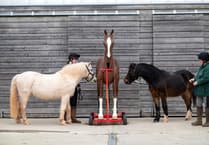A LATCHLEY engine house hidden beneath the ivy has been uncovered and partially restored thanks to local resident, David Garratt.
The Hingston Consuls engine house dating back to the 1880s has since become a passion for David and has taken him on a journey of discovery as he learns about the history of this once-working engine house.
David’s journey to restoring the relic began when he moved in with his partner Christine. The engine house was in one of Christine’s fields and up until four years ago, David had taken little interest in the structure. However, on a summer’s day in 2018, David’s interest was sparked and his journey to restoring a part of Cornwall’s once thriving industry began.
‘All I recall is taking a long, thoughtful look at the remains and thinking, ‘I should do something with those’, said David.
‘It took me 6/7 years to learn the mining history. I went down to Truro to the county records office and found out where the tunnels go and it just went on from there. It is a strange feeling that up to 450 feet below where horses occasionally graze, men with picks and shovels dug out the stone containing copper ore, their uncomfortably hot, damp and confined workplace, lit by just a candle fixed to their helmets.’
As David began digging, he uncovered internal walls that were still in tact and since this discovery he has been motivated to continue exploring the structure.
David said: ‘In all honesty, had it not been for the fact that as I dug deeper, the exposure of undamaged interior walls, turned my curiosity into an obsession, then the engine house would have changed very little.’
So far David has worked on the engine house for four seasons and completed two phases of restoration. Removal of the roots of the ivy, which covered the exterior of the chimney and building, revealed some solid stonework underneath. The gable wall is also ivy free, as is the boilerhouse side wall.
A Tamara Landscape Partnership grant, which is jointly funded by the National Lottery Heritage Fund and Historic England (HE) provided David with funding for a conservation assessment to be conducted by Clive Meaton of Cotswold Archaeology and also funded a structural condition report by Bea Engineering design.
These reports will assist David with phase three of his project which will be repointing and capping of the walls and hopefully, repairs to the top of the chimney.
The restoration project has not been for the faint-hearted as David came to realise when a stubborn tree resulted in him sustaining a painful injury. When felling a 30-ft hawthorn tree on the site, a felling error resulted in David being struck on the back of the neck by the tree. Luckily David’s son was there to offer a helping hand, and although the tree has damaged David’s neck, the incident hasn’t stopped him from pursuing his obsession.
David continues to dig on and enjoys visiting the engine house, especially in the summer months to take in the spectacular views and to imagine what life would’ve been like for the miners. On David’s birthday it has also become a tradition to come up to the engine house and have a barbeque in the nearby field and to light a fire in the chimney.
David said: ‘I just like coming up here. In the evenings I’ll sit up here when the sun is coming down. I enjoy it and I enjoy discovering things and it keeps me active. The last four years has, for me, been a journey of learning and research.It’s a fascination. Not everyone has one in their back garden.’




